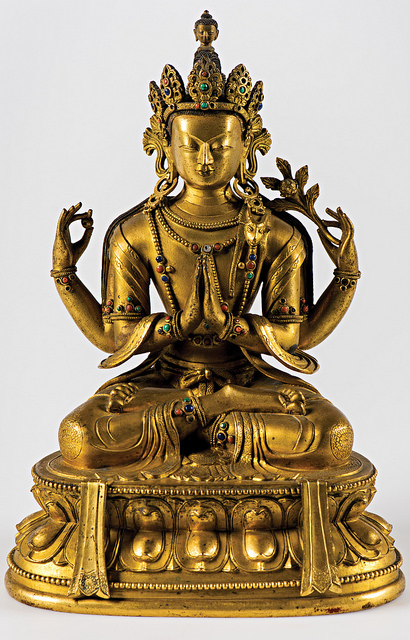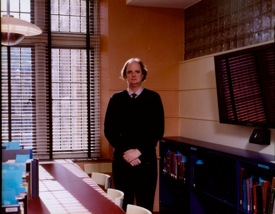
Today’s post comes from Isis Lecaro, class of 2018 and Art Center Student Docent.
Embodying Compassion in Buddhist Art: Image, Pilgrimage, Practice—the first exhibition of its kind in the United States—opened this spring at the Art Center. The occasion was marked by a symposium in Taylor Hall on April 23 called “Many Faces, Many Names: The Bodhisattva of Compassion.” After a gracious introduction by Art Center Director James Mundy, curator and Vassar professor of art Karen Lucic took to the stage. She first mentioned exhibition-related events taking place in the Villard Room of Main Building throughout the week: three visiting lamas from the Drikung lineage of Tibetan Buddhism would construct a sand mandala focused on Chenrezig (the Tibetan name for Avalokiteshvara, the bodhisattva of compassion), give lectures, and perform a dissolution ceremony of the mandala atSunset Lake. She continued by thanking individuals, including her seminar students, who helped put together the exhibition over the course of three and a half years. She noted the many resources available to navigate the exhibition including a catalog, a website (http://pages.vassar.edu/embodyingcompassion/), and a mobile app created by undergraduates at both Vassar and Duke University that guides a visitor through the exhibition on a virtual tour.

Professor Lucic then introduced us to the subject of the exhibition: the many forms of, and practices surrounding, Avalokiteshvara, a bodhisattva—a princely, enlightened being in the stage before becoming a Buddha, who helps the suffering and has limitless compassion for all sentient beings. She noted that this is the first-ever exhibition in the U.S. to track Avalokiteshvara across Asian cultures. Essential to identifying Avalokiteshvara are his iconographic markers, especially the lotus flower and a small Amitabha Buddha sitting in his crown, as well as his many different names (Avalokiteshvara in India, Karunamaya in Nepal, Chenrezig in Tibet, Guanyin in China, and Kannon in Japan). A common marker of bodhisattvas in general is their princely opulence and gender fluidity. Many are adorned in luxurious robes, covered in jewelry and even, mostly in the case of sculpture, depicted as made of gold. Additionally, many representations of bodhisattvas include female bodily features and feminine attributes. Avalokiteshvara has multiple roles as a bodhisattva, but his most important and well known is as a compassionate helper to those who are suffering. He is also an agent who activates our own inherent compassion. For this reason he is a beacon for Mahayana Buddhism, the Buddhist tradition that is the focus of the exhibition.
Professor Lucic next introduced Karen Hwang (Vassar Department of Art), who used the paintings in the Dunhuang caves of China to show how Buddhist art illustrates essential elements of the religion’s values and practices. The Dunhuang caves are hundreds of man-made caves on the Silk Road, created during the 5th century. Professor Hwang focused on two panels of a specific cave mural that depict Buddha Shakyamuni about to reach enlightenment through meditation. Surrounding the Buddha is a chaotic mass of indiscernible figures, which Professor Hwang explained are embodiments of the potential distractions or temptations that would make him break meditation. The entire composition is in the same three colors of blue, a cream white and brown, making it even harder to tell the figures apart. The painters aimed for illegibility to give the viewer a sense of confusion when first viewed, Hwang explained. They made the Buddha, who is much more clearly rendered, the calm amidst the chaos to illustrate his inner peace.

On the second panel, the focus is on the Buddha’s past lives, primarily his work as bodhisattva Avalokiteshvara. A scene of Avalokiteshvara’s self sacrifice can be seen. As Avalokiteshvara can be reborn infinitely (until he becomes a Buddha), he decides to sacrifice himself to a group of starving tigers stuck in a pit. A hungry mother and her cubs are starving to death, and are so weak they can barely even look up at Avalokiteshvara. He cuts his throat, in hopes that his blood will awaken the tiger’s hunger, removes his robes, and throws himself into the pit. The bodhisattva is depicted as laying himself out so that all of the tigers can eat the fleshiest part of his body. This story shows the lengths to which Avalokiteshvara is willing to go to help other beings. This story is depicted in a circular manner, with each stage of the story creating a circle. While this makes it seem illegible at first, its circularity reinforces the narrative by clarifying that this episode is just one act of his many compassionate acts. The two panels, as they become clearer and clearer to the viewer through careful study, are meant to emulate the ways in which Buddhism can illuminate the ignorant and provide wisdom in time-release fashion (with hard work). So, the wall painting is not merely about the scenes; the painters had the intention of making them discoverable in a way that demonstrated the process of spiritual awakening and the path to enlightenment.
The next speaker was Michael Walsh (Vassar Department of Religion), who explained and helped illustrate key components to temple spaces. He focused on the importance of the Lotus Sutra, in which the name of Avalokiteshvara’s name is revealed to mean “he who observes the sounds of the world,” as well as that of the Heart Sutra, which explains that all phenomena are full of dependency. Both of these texts are foundational to Buddhist thought and belief. Walsh then took us on a virtual tour of a Buddhist temple in China. He explained that the temple itself is an active space in which to interact with the deity. Often one must ascend many flights of stairs to reach the temple, and even more to reach the primary icon. Most temple spaces have layered levels and are complex, Walsh explained, which emulates the back and forth, ascent and descent of the spiritual involvement of the Buddhist practitioner. Many temples are noisy, crowded, and smoky with incense, creating a wall of sound and scent in the common spaces. Avalokiteshvara (who is Guanyin in China) is popular for his power to heal suffering, and so many visitors place their hands on the red pillars—thought to be full of the bodhisattva’s powers—in front of his image in hopes of healing aching body parts. Walsh brought to life how the temple does not merely hold embodiments of important deities, but also facilitates physical interaction with the space as a part of a temple-goer’s spiritual practice.
The final speaker was Sherry Fowler, Professor of Japanese Art at the University of Kansas, who focused on the relationship between prints and pilgrimage in Buddhist tradition in Japan, where the bodhisattva is called Kannon. Kannon takes many bodies or guises to save beings from various perils, such as fires, floods, and shipwrecks. According to Fowler, pilgrimage to Kannon sites started in the 11th century. At some sites, pilgrims would not necessarily see the icon or object of devotion, as some had special restrictions, and so souvenir images and items became a popular way of interacting with the image, despite not being to see it. Having the printed image establishes a connection between the pilgrim and the deity, Fowler explained. This way, believers can later call on the deity for help when most needed. Pilgrims might also collect calligraphic markers done by the monks at the site, featuring a seal with the temple’s name. Traditionally these different small images could be assembled and displayed on a scroll, or even in a collector’s book. In closing, Fowler offered a synthesis, saying that pilgrimage prints served as proof of the pilgrimage; as souvenirs; as a portrait of the icon; as a means of establishing a personal connection to the deity; as a way to gain and transfer merit; as a way to commemorate the dead; and, ultimately, as a way to console the living.




